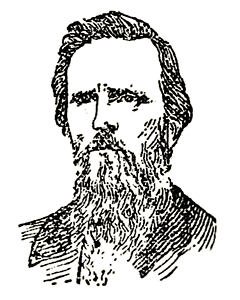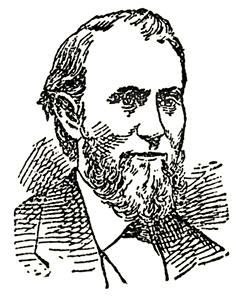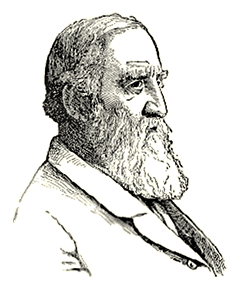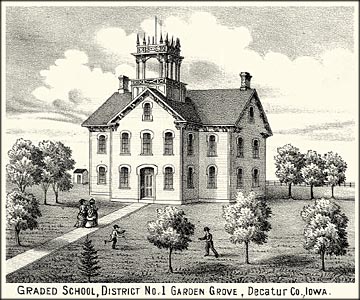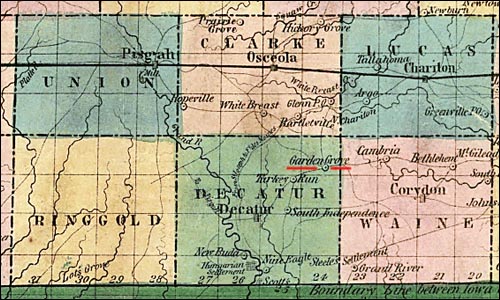
|
Biographical and Historical Record of Ringgold and Decatur Counties, Iowa (Chicago: Lewis Pub. Co., 1887) |
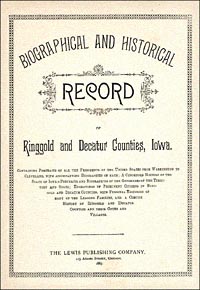
|
Wm. Smith on Mormonism | Saints Herald | The Return | Doctrines of Mormonism
Elijah Banta | History of Decatur Co. (1915) 2nd copy 3rd copy | Lamoni in 1929
|
BIOGRAPHICAL AND HISTORICAL RECORD OF Ringgold and Decatur Counties, Iowa. CONTAINING PORTRAITS OF ALL THE PRESIDENTS OF THE UNITED STATES FROM WASHINGTON TO CLEVELAND, WITH ACCOMPANYING BIOGRAPHIES OF EACH; A CONDENSED HISTORY OF THE STATE OF IOWA; PORTRAITS AND BIOGRAPHIES OF THE GOVERNORS OF THE TERRITORY AND STATE; ENGRAVINGS OF PROMINENT CITIZENS IN RINGGOLD AND DECATUR COUNTIES, WITH PERSONAL HISTORIES OF MANY OF THE LEADING FAMILIES, AND A CONCISE HISTORY OF RINGGOLD AND DECATUR COUNTIES AND THEIR CITIES AND VILLAGES THE LEWIS PUBLISHING COMPANY. 113 ADAMS STREET, CHICAGO. 1887. |
|
BIOGRAPHICAL SKETCHES. 539 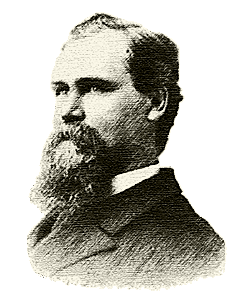
ZENAS H. GURLEY, of Pleasanton, Iowa, was born February 24, 1842, in Hancock County, Illinois. The name Gurley is probably Scotch in the original, but spelled differently, in some instances by leaving out the "e," and again by inserting an "o," making it Gourley. The first of the name of which we have any account in America, was William Gurley, born in 1665, and stolen from some part of Scotland, probably Edinburgh, at the age of fourteen years, left in this country, and brought up in the family of Rev. Mr. Stoddard, of Northampton, Massachusetts. He left but one child -- Samuel Gurley, born May 17, 1687, who was the first that settled at Mansfield, Connecticut. He died February 23, 1760. His father, William, was a sincere follower of the Lord Jesus, and Samuel, it is said, "was distinguished for his piety, and was eminently useful in the cause of religion and humanity." Samuel's wife was Experience Rurt, daughter of Nathaniel Rurt, of Northampton, Massachusetts. She died in the year 1768. Samuel Gurley, son of Samuel aforesaid, was born June 30, 1717, married Sarah Ward, by whom he had eight children, and after the death of his wife married Hannah Walker, by whom he had five children, and after her death 540 HISTORY OF DECATUR COUNTY. married Hannah Bosworth. Samuel's fourth child by the second wife was Zenas, who married L. Dimock, and after her death E. Hovey, of New York, by whom he had four children -- Henry, Eunice, Lovina (Mrs. Morris, of Chicago, who was one of the charter members of the Home for the Friendless, of that city), and Zenas H., born at Bridgewater, Oneida County, New York, May 29, 1801, and died August 28, 1871. He married Margaret Hickey, daughter of John and Margaret Hickey nee Castleman, born January 1, 1808, and who still survives her husband. By this marriage, which took place at Williamsburg, County of Dundas, Canada West, in 1825, he became the father of eleven children. He was reared in the Christian religion as taught by the Presbyterian or Congregational church, and in early manhood united with the Methodist church, and became a local preacher therein. In 1837, with his wife, he became a convert to the faith of the Latter Day Saints, and shortly afterward moved to Missouri in the expectation of finding "Zion," where, after sharing with others the vicissitudes, perplexities, suffering and disappointment attendant upon such an ignis-fatuus, quitted the State in the spring of 1839, taking refuge in Illinois. After the death of the Smiths, in June, 1844, Mr. Gurley moved into Nauvoo, where he resided until the autumn of 1846, and was driven out with that portion of the church which could not get away in the spring previous with Brigham Young, with whom the great body of the church, together with church archives, etc., went into Utah. He was a prominent and successful minister in the church, and an over-ardent admirer of the prophet, Joseph Smith, and would have gone with Brigham Young and associates, believing them the truest exponents of the prophet's policies and measures (and his position enabled him to know), but the providential death of his team, a fine pair of horses, forbade his intended move, and instead of going West he, with his family, was barely enabled to get to Jo Daviess County, Illinois, having lost nearly all his earthly possessions at Nauvoo. At Jo Daviess County, he was materially helped by the Masonic fraternity, of which he was a member, and, considering his very straightened circumstances, this help was most opportune. Mr. Gurley with family moved near Burlington, Wisconsin, in 1849, and in 1851 to Yellowstone, some ten miles east of Mineral Point, in the western portion of the State. Here at this point and vicinity he did preaching and baptized a number of converts, but becoming dissatisfied with the developments which were taking place under Young, Strang, Wm. Smith (the prophet's brother), and others (who were leaders of Mormon factions), believing now, that they were all gone astray, and fearing that the prophet, Joseph, had made some fatal errors before his death, and that these men were but continuing them, he determined, in company with Jason W. Briggs and a few others, in 1852, upon a reformation or revolution, hence he renounced allegiance to or association with any and all of these leaders aforesaid, and he denounced polygamy which was then being openly taught in Utah, and which had been secretly taught for years in the church; he also rejected "marrying for eternity," called also "sealing for eternity," or "spiritual wifery," that is to say -- "if a man's wife die, he has a right to marry another and be sealed to both for eternity; to the living and the dead," thus establishing polygamy in heaven; and further of this doctrine and practice by way of explanation the prophet, Joseph, said in May 1843 (as recorded in his history), that "except a man and his wife enter into an everlasting covenant and be married for eternity, while in this probation, by the BIOGRAPHICAL SKETCHES. 541 power and authority of the holy Priesthood, they will cease to increase when they die; that is, they will not have any children after the resurrection. But those who are married by the power and authority of the priesthood in this life, and continue without committing the sin against the Holy Ghost, will continue to increase and have children in the celestial glory." Against these and other delusive doctrines Mr. Gurley and associates declared, and for the same were excommunicated from the church and branded as "apostates." They organized their movement in 1852, however, and commenced the publication of the Saints' Herald in January, 1860 (which sheet is being still continued at Lamoni, Iowa,) with Wm. Marks, Zenas H. Gurley and Wm. W. Blair as publishing committee, and Isaac Sheen, editor; and one fact well worthy of notice here is, that in their first issue, the leading editorial is devoted to the subject of polygamy, averring that the prophet, Joseph, did give the revelation, or command enjoining it, and that it was given as a curse, because of the idol which had been set up in the hearts of the church. Joseph Smith, the present president of the Reorganization came and united with them in April, 1860, since which time the policy and position of the church as touching his father's complicity in polygamy has been changed from an averment of, to a flat denial. Of Mr. Gurley's children -- John E. was a soldier in the late Rebellion, entered the service as Captain of Company C, Thirty-third Regiment Wisconsin Volunteers. Was forty days at Vicksburg, after which was transferred to staff duty of the Fourth Division of the Seventeenth Army Corps, and served upon that staff with efficiency and success until near the close of the war, when he was promoted to the office of Colonel of the One Hundred and Thirty-fifth United States Colored Infantry, by Abraham Lincoln, and transferred to the staff of General Frank P. Blair. Colonel Gurley fought at Vicksburg, Coldwater, Jackson, and with the Fourth Division subsequently, wherever engaged, being in the heaviest of the fight on the 22d and the 28th days of July, before Atlanta, Georgia, and thence to the sea with General Sherman's army, taking part in the grand review at Washington. He was mustered out of service at Louisville, Kentucky, in December, 1865, and returning to Wisconsin he engaged again in the practice of the law, he having been admitted to the bar at the opening of the war, and previously received his education at Lombard University, Galesburg, Illinois. In 1868 he was taken sick, and with a constitution broken from the effects of the war, was unable to resist the attack of death, and he passed away quietly and peacefully in April, 1869, in full assurance of eternal life, being but thirty-one years of age. Another, the eldest son, Samuel H., died at Lamoni, Iowa, a few years since in the fiftieth year of his age. He was a faithful follower and minister for Christ. The youngest son, Edwin H., is also a minister of the gospel, and resides at Lamoni, and another, George W., at Sandwich, Illinois, who is a thorough business man. Zenas H., whose name appears at the head of this sketch, came to Decatur county in November, 1870; married Gracie Robinson in 1872, making his home here since that date. His time has been largely occupied as a traveling minister for the Reorganized Church of Latter Day Saints, having received from the church the same honor conferred upon his father, that of an Apostle, of the quorum of Twelve. In the year 1874 he was sent as a missionary in charge of Utah, where he battled with polygamy and its concomitants, remaining in Utah nearly one year, but continuing, whether in the Territory or out of it, to wage war against the "twin relic" -- returning to Utah again in 1878, at which 542 HISTORY OF DECATUR COUNTY. time he was enabled to make a more careful and thorough study of the Mormon problem. Returning home he was sent, in company with Elder E. L. Kelly, to Washington, to urge upon the Forty-seventh Congress, the necessity of additional legislation for Utah. He took an active part with his colleague, working night and day for three months for the passage of the Edmunds Bill, and for labor performed there has received many flattering compliments, both from individuals and the press. In 1882, he was appointed with Joseph Smith, a committee, to wait upon the Secretary of State, of the United States, for the purpose of obtaining further recognition for the church, and making distinction between the Reorganization and the church in Utah. Was first introduced to that officer by Senator McDill and Hon. W. P. Hepburn, who expressed a wish that Mr. Gurley should appear in writing, which was readily agreed to, and in March, 1883, being joined by Mr. Smith, appeared before said officer, again being introduced in this interview by Senator Allison, and Hon. W. P. Hepburn. He returned East the succeeding fall, going as far as the isle of Grand Manan, in the Bay of Fundy, traveling as a missionary, and all these years supporting his own family, believing it "more blessed to give, than to receive," though, of course, he made no financial gain during that period, but steadily declined. In 1878, the church in General Conference, adopted the "Inspired Translation of the Scriptures," by Joseph Smith, together with the Book of Mormon, "The revelations of God in the Book of Doctrine and Covenants," and the revelations this present Joseph Smith had received, or ever should receive as a rule of faith and practice -- whereupon Mr. Gurley, being in Utah at the time, immediately returned home and sent in his resignation as an officer, being unwilling to serve a church who took such (to him) insane position. His resignation was accepted the following spring upon that issue, but in September, of 1879, a compromise position was reached, wherein it was agreed that the revelations of Joseph Smith should not be made a test of reception into or fellowship in the church (thus revoking the act which made them the law of God to the church), whereupon, Mr. Gurley was reinstated, and went to Washington and the East, doing the work as referred to. During his labor at Washington, he was frequently questioned whether or not, he and his people believed in gathering the church together in one or more localities, to which he responded in the negative, because of the act of the church in September, 1879, referred to above. This position could not fail, as it did not, to make prestige and friends for the church with the Government, for this gathering of the church together, concentrating its power for religious and political purposes, had from its inception down till to-day proven abortive of good, and highly detrimental to the Government. Mr. Gurley calls attention to the paper lodged with the Secretary of State, setting forth the only principles and doctrines held sacred and indorsed by the church in General Conference unanimously in April, 1883, as being in perfect accord with the position cited above. But to his great surprise and disappointment in Heralds for 1885, he is charged with having denied the faith, by one of the presidents of the church, alleging as proof that he denied the gathering, and also the law of tithing (which provides that the individual member of the church shall give all his surplus property into the Bishop's hands, and after that shall pay one-tenth of all his interest annually -- and those refusing this shall not be worthy to abide in the church. See D. and C., Sec. 106), and citing as law BIOGRAPHICAL SKETCHES. 543 against him, that the church was bound to "receive and respect Joseph Smith's words and commandments, the same as if from God's own mouth," -- to all of which Mr. Gurley plead "guilty," provided that be the faith of the church. He held, however, that it was not, but in April of that year the General Conference refused to sustain him as an officer, which was the result of the controversy in question, whereupon, after the elapse of another year, and seeing the disposition of the church, as expressed by leading authorities, was to reinstate and establish the revelations of Joseph Smith aforesaid, as the law to the church, -- the rule of faith and practice, and believing that to be a gross violation of the Acts of 1879 and 1883 (which last indorsed the paper presented to the Secretary of State) Mr. Gurley concluded to withdraw from the church entirely, so in April of the year 1886, together with his wife, and mother, aged seventy-eight years, his brother Edwin H. and wife, and Elder Jason W. Briggs, one of the founders and fathers of the church they withdrew, refusing to accept the revelations of Joseph Smith as a rule of faith and practice, believing that he proved himself an unsafe leader. They affirm the gospel as taught by the Saviour and the original witnesses, denying to Joseph Smith, or any man or angel the right to add a codicil to the last Will and Testament of Christ, but, believing this to have been done, and that it has proved the curse an bane of the Mormon church, and also of the Government, and the Reorganization now insisting that these revelations aforesaid are God's law to the church -- this is laid as sufficient cause for their act, holding that the Mormon problem can never be solved successfully by any process other than a thorough and critical examination of all of Joseph Smith's revelations, and their errors and evils exposed. To illustrate more fully to the reader's mind the benighted and terrible condition of the leaders of the church, and that the devilish doctrine of polygamy was taught as early as 1843, and that, in teaching this, the leaders fulfilled the prophetic prediction of the Apostle Paul, as recorded in I. Timothy, iv:1-2, repeating also the predicted history of the past as seen in II. Peter, ii: 1-2, Mr. Gurley submits the testimony of Ebenezer Robinson and wife, who are well known in Decatur County (and Mr. Robinson throughout the State), being perfectly reliable. "TO WHOM IT MAY CONCERN: Mrs. Robinson having died since the execution of the foregoing, and some question arising as to how and wherein the said Hyrum Smith (one of the first officers and leaders of the church) had given special instructions to Mr. Robinson, he was questioned in regard to the matter, whereupon he executed the following: "TO WHOM IT MAY CONCERN: 544 HISTORY OF DECATUR COUNTY. of November, or in December, 1843, Hyrum Smith (brother of Joseph Smith, President of the Church of Jesus Christ, of Latter-Day Saints) came to my house in Nauvoo, Illinois, and taught myself and wife the doctrine of spiritual wives or polygamy. The Gurleys take to the ministry of the gospel and practice of the law naturally, one of the family having been Attorney-General of the State of Louisiana, and another, John A. Gurley, Universalist minister, and member of Congress, from Ohio. Z. H., himself, is noted as an able reasoner, and possessed of good oratorical powers, having, as a rule, full houses of attentive listeners wherever he speaks, and, notwithstanding the opprobrium of the name Mormon, has for years been permitted the use of various church-houses, assisted by ministers of various denominations, and all simply because he preaches the gospel, and abuses no sect nor people. He has very many firm friends in the county. EBENEZER J. ROBINSON, of Lamoni, Iowa, has been a resident of Decatur County since the autumn of 1873, when he made his home on section 16, Fayette Township. He at that time bought two improved farms in that section, each containing 160 acres, and later added an additional eighty acres. He also owns 120 acres of land in Bloomington Township, and forty acres of timber land in Harrison County, Missouri. His parents, Joseph and Maria (Wood) Robinson, were natives of Vermont and New York respectively. They were married in Oneida County, New York, and there the subject of this sketch was born, October 19, 1835. In the spring of 1841 the family removed to Hancock County, Illinois, where they joined the Latter-Day Saints. The father was a man of large means, and the expulsion of the Saints from Nauvoo, Illinois, was disastrous to him financially, although he managed to save much of his property, and is quite wealthy. The family on their way to Salt Lake City, spent two winters where Omaha now stands. The subject of this sketch grew to to manhood at Farmington, Utah Territory. In 1848 he renounced Mormonism as taught by Brigham Young and his apostles and later joined the Reorganized Church of the Latter-Day Saints, of which he is still a member. He was engaged in stock-raising in the mountains of Montana and Utah, where he spent twelve or thirteen years. In 1861 he began farming and stock-raising in Alameda County, California. He was married in that county in 1863, to Miss Chloe A. Young, a native of Hancock County, Illinois, and a daughter of Daniel P[arks] Young. They have seven children living -- Delmer E., Amelia C. and Walter Y. Their secind child, Album, died in California in his third year, and Marion, their sixth child, died in Fayette BIOGRAPHICAL SKETCHES. 545 Township, Decatur County. In 1886 Mr. Robinson erected a fine residence in Lamoni, where he now resides. He has three dwelling houses on his farms in Fayette Township, two and a half miles from Lamoni. He has stocked most of his property, and has rented all of it on five year leases. In his political views Mr. Robinson casts his suffrage with the Republican party.(remainder of pages 545-587 not transcribed) 588 HISTORY OF DECATUR COUNTY. 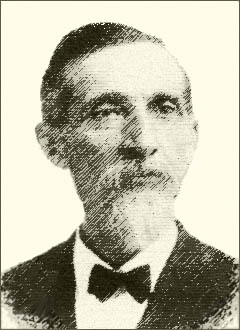
HENRY A. STEBBINS, of Lamoni, is a native of Ohio, born in Lucas County, January 28, 1844, a son of Charles and Julia E. (Pease) Stebbins, the father a native of Massachusetts, and the mother born in Connecticut, a daughter of Chandler Pease, a soldier of the war of 1812, who died September 22, 1837. The parents of our subject were married in Ohio, where both were reared, and to them were born five sons and one daughter -- Henry A., our subject; Charles M., a man of wealth, who has spent the past five years traveling in Europe; George I died at Denver, in 1877; Homer P., living at Atchison, Kansas; William R., a general banker of New BIOGRAPHICAL SKETCHES. 589 York City, with branch offices at Deadwood, Dakota, Billings, Miles City and Livingstone, Montana, and at other points in Dakota, Colorado and Wyoming; and Harriet S., wife of Dr. Thomas Stevens, of Mechanicsburgh, Pennsylvania. When our subject was seven years old his parents removed to Rock County, Wisconsin, and there he grew to manhood. August 5, 1862, he enlisted, during the late war, from Winnebago County, Illinois, in Company B, One Hundred and Seventy-fourth Illinois Infantry, and was in General Buell's department, in Kentucky. He was at the battle of Perryville, although not actively engaged, and soon after was broken down by hard marches, and was finally sent to a hospital, at Danville, Kentucky. March 20, 1863, he returned to his mother's home, in Winnebago County, his father having died in 1858, making his home with her till her death, which occurred in 1874. Henry A. Stebbins was married at Burlington, Iowa, to Miss Clara B. Sellon, who was born in Shiawassee County, Michigan, December 13, 1858, a daughter of W. R. Sellon, a resident of Burlington. Mr. and Mrs. Stebbins have one daughter -- Helen V., born July 4, 1880, in Plano, Illinois. In November, 1880, Mr. Stebbins became identified with the business interests of Lamoni, when he became associated with David Dancer and A. S. Cochran in the grain and lumber business, under the firm name of Dancer & Co., which partnership was dissolved a year later. In the summer of 1863 he united with the Reorganized Church of Jesus Christ, of Latter-Day Saints, and in 1868 began service in the ministry, since which he has devoted his life to the service of his church, excepting during the one year named above, his mission fields having been principally in Wisconsin, Minnesota, Michigan and Iowa. Before coming to Lamoni Mr. Stebbins was associate editor of the Saint's Herald, at Plano, Illinois, from April, 1876, till October, 1880. He is presiding elder of the Decatur District, including six counties in Iowa -- Decatur, Wayne, Appanoose, Lucas, Union and Ringgold, and two counties in Missouri -- Harrison and Worth. In the spring of 1886 he resigned his charge as pastor of the Lamoni congregation and as superintendent of the Sabbath-school. He is secretary and recorder of his church, and as such, keeps a record of names of all the members throughout the world, including churches in Australia, Society Islands, England, Wales, Denmark, Switzerland, United States and Canada, showing their births, baptisms, and confirmations; also the official record of all ordained to the ministry. And as secretary he issues licenses and certificates of appointment to the ministry, also other official documents of the church.(remainder of pages 589-649 not transcribed) 650 HISTORY OF DECATUR COUNTY. DANIEL P. YOUNG was born in Cayuga County, New York, January 31, 1808. His parents, David and Sarah (Parks) Young, were born, reared and married and lived all their lives in the Empire State. Our subject was reared to a life of toil on a farm, receiving only the educational advantages common to the poorer classes of the early day, but a life partaking much of adventure -- changes of residence, a citizen of different States -- has enabled him to learn much of the world and its ways, and now in his old age he is full of reminiscences and recollections of an active life. He was married in the State of New York in 1832, to Miss Martha Ford, who was born in 1812, and now for fifty-four years have they traveled life's journey together, experiencing many severe trials and hardships, as well as many pleasures and joys. In 1833 they moved to Geauga County, Ohio, where they lived until 1844, when they joined their fortunes with the Latter-day Saints, and made their home in Hancock County, Illinois. After the exodus from Nauvoo they, in 1846,made their home near Council Bluffs, Iowa, living on a farm until 1852, when they crossed the plains on their weary way to Salt Lake. They lived in Utah until 1861, when we again find them on the emigrant train, en route to Almeda County, California, where they again made a home, and engaged in farming and stock-raising until 1873, when they returned to Iowa and settled on section 18, Fayette Township, Decatur County, to spend the rest of their lives. Mr. Young has been a cripple since 1874, the result of inflammatory rheumatism, but otherwise is in the enjoyment of good health. He and his wife have a family of twelve children, six of whom are living -- Celia, wife of A. B. Moore, of Fayette Township; John and Alburn, in California; Francis D.; Chloe, wife of E. J. Robinson, of Lamoni, and David D. Ansil, Delmar, and four infants are deceased. Francis was married in Utah to Gracey, daughter of Dr. Dennis, of Salt Lake. After some years' residence in California he lived for a time in Montana, coming thence to Iowa in 1874. He has six children -- Martha, Edwin, Hattie, William T., Talitha and Clarence. David married Florence, adopted daughter of Samuel Gurley, and has four children - Chloe, Samuel, Ansil and Roy M. The entire family are members of the Reorganized Church of Latter-Day Saints. J. S. KENDALL, a prominent farmer and stock-raiser, is one of the pioneers of Decatur County, and resides on section 35, High Point Township, where he owns 400 acres of excellent land. He was born in Gallatin County, Kentucky, in 1824, son of Noah and Elizabeth Kendall, also natives of Kentucky. He came to Decatur County in 1856, and settled upon his present farm. He first purchased 250 acres, for which he paid $10 per acre. He has added to his farm until it has reached its present size. He has also given 160 acres to his children. He was married in Indiana, August 26, 1847, to Elizabeth Ammermon, daughter of Daniel and Martha (Taylor) Ammermon, natives of Kentucky. Their children are -- La Fayette, who married Celia Swope, and has had four children -- Cora B., Harley E., Maggie and Bertha, deceased; Louisa is the wife of Jesse Adair, and they have four BIOGRAPHICAL SKETCHES. 651 children -- James S., Harry M., Luther A, and Bertha M.; Edward is deceased; Martha, William; Marion married May Fleming, and their children are -- Carl W. and Wilda M., Angeline and Edwin. The deceased were Nelson, Philander and Henry. Mr. Kendall has held the minor school and township offices with satisfaction. He is a member of the Masonic fraternity, Lewisburg Lodge, and himself and wife are members of the Methodist Episcopal church. Mr. Kendall commenced life without a dollar. He has accumulated a competence by hard work, energy, perseverance, industry and economy. Politically he is a Republican. Postoffice, High Point.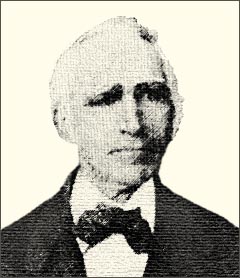
EBENEZER ROBINSON has been a resident of Decatur County since April 1855. At that time he settled on section 15, Hamilton Township. Mr. Robinson purchased 160 acres of land in 1854, of Thomas Grim, at which time there were only some seventeen families in the township. On this land he settled. He also entered and purchased 640 acres adjoining and near his first purchase. Here he made his home until April, 1882, when he sold his homestead to his son-in-law, Zenas H. Gurley. At the time he settled there, 1855, there was but one mill in the township, Allen Scott's horse-mill, at which he paid 33 cents a bushel to get corn ground. In 1858 there were five steam mills in operation in Hamilton Township. Mr. Robinson was born in the town of Floyd, Oneida County, New York, May 25, 1816. His father, Nathan Robinson, removed to that State from Vermont that same year. He was a native of Connecticut, and died in Ohio at the advanced age of ninety-five years. The mother, Mary (Brown) Robinson, was of New England birth and died in March, 1826, when Ebenezer was ten years old. Our subject was reared on his father's farm until fifteen years of age, when he went to Utica and began learning the printer's trade, in the rooms of the Utica Observer, E. A. Maynard, publisher. In June, 1833, he started for Ohio and landed at Cleveland July 5. Three of his brothers, Clark, Nathan and Samuel, had preceded him and settled in Russell Township, Geauga County. He remained with his brothers until August, then went to Ravenna, Portage County, and engaged as compositor on the Ohio Star, published by L. L. Rice. In December of that year Mr. Rice sold out to other parties, and Mr. Robinson went to Hudson and worked on the Observer, a Presbyterian paper. In May, 1834, he returned to New York, via Niagara Falls, to visit his old home, and the following winter taught school. At this time he was in his nineteenth year. The following May he returned to Ohio, where, in the meantime, his father had removed. Soon after he went to Kirtland and went to work in the office of the Latter-Day Saints' Messenger and Advocate, published by F. G. Williams & Co., and edited by Oliver Cowdery. This paper was the organ of the church of the Latter-Day Saints, usually called Mormons. At that time Mr. Robinson was not a member of that church, but soon found, to his surprise, that they taught the gospel, with all its gifts and blessings, as set forth in the New Testament scriptures, and that the Book of Mormon taught the same, and became convinced, in his own mind, of the truth as taught by them, and October 16, 1836, was baptized by Joseph Smith, and has ever since held to the doctrine of that church. Polygamy is not, and never has been, countenanced by that branch of the church to which Mr. Robinson belongs, and it is stoutly and emphatically forbidden in the Book of Mormon. December 13, 1835, 652 HISTORY OF DECATUR COUNTY. Mr. Robinson was married to Miss Angeline Eliza Works, a native of Cayuga County, New York. Soon after he was baptized he was ordained an elder, and June 2, 1836, went on a mission to Richland County, Ohio, where he baptized several persons. He returned in July and soon after went on a mission to Oneida County, New York, where he baptized several persons, including a brother and a sister. He returned to Kirtland, and in April, 1837, removed to Caldwell County, Missouri, and in the summer of 1838 he was engaged in the publication of the Elder's Journal, in Western Missouri, which was then the headquarters of the church. At the State election, held at Gallatin, the following August, trouble began between the Missourians of that county and the Mormons, which resulted in the issuing of an order by Governor L. W. Boggs, that the Mormons should be "expelled from the State, or exterminated." Consequently the whole church of about 12,000 members fled to Illinois. Mr. Robinson went to Quincy and worked on the Quincy Whig until May, 1839, when he removed to Commerce, now Nauvoo. In June, 1839, in company with Don Carlos Smith, youngest brother of Joseph Smith, he published the Times and Seasons, a semi-monthly journal. In August, 1841, his partner died, and Mr. Robinson purchased the entire paper and connected with it a general job office and stereotype foundry and bindery. February 2, 1842, he sold out the whole business to Brigham Young & Co. and June 18, 1844, left Nauvoo, accompanied by his wife and Sidney Rigdon and family, for Pittsburg, Pennsylvania, where they arrived on the 27th, the day Joseph Smith was killed. After this tragic event Brigham Young assumed control of the church, ignoring the claims of Elder Rigdon, whose right it was to preside. Here the church divided, the greater part adhering to Brigham Young, while a minority, of whom Mr. Robinson was one, adhered to Elder Rigdon and ever after opposed Brigham Young and his doctrine of polygamy. Mr. Robinson established a paper at Pittsburg, called The Messenger and Advocate of the Church of Christ. In May, 1846, he removed to Greencastle, Franklin County, Pennsylvania, where he remained until April, 1855, when he removed to Decatur County. Mrs. Robinson died April 8, 1880, and February 5, 1885, Mr. Robinson married again. The first wife had but one child, a daughter, Mrs. Gracie Gurley, wife of Zenas H. Gurley. Mr. and Mrs. Robinson have one child, born June 26, 1886. Mr. Robinson is highly esteemed in the community where he is known as a Christian gentleman and a worthy citizen. (Remainder of biographical section transcribed.) |
|
782 HISTORY OF DECATUR COUNTY. LAMONI. Lamoni is a bright village of 400 inhabitants in Fayette Township. It is on sections 2 and 11, and was laid out in 1879, by a company under the auspoces of the Chicago, Burlington & Quincy Railroad Company. The township is largely settled by the Latter Day Saints, a very thrifty and industrious class of people. They are strongly opposed to polygamy, regarding the Utah branch as apostates. The Order of Enoch was organized in 1870, and representatives were sent to this region, to buy land. Finding much of the fair prairie of Fayette and adjoining townships in a state of nature, they purchased a large quantity of land here, and the immigration commenced. At this time there was in this vicinity only a farm-house, on the eighty-acre farm just north of Lamoni. It was owned by a Mr. Shepherd, whose widow afterwards sold it to F. Drummond. The latter erected the house now occupoed by E. H. Dancer, in 1877. The original farm-house is now owned by J. Foreman. The next nearest farm was that of E. Ferguson, half a mile east of where is now Lamoni. A. J. Green was, when he died, the oldest settler in this region, and he was one of the early Saints. The first Saint to settle in this locality, however, was named Walker. The third of the three houses on the plat of Lamoni before 1879 was built by the Order of Enoch for a farm-house. It is now owned by William Deam. Z. H. Gurley had the first stock of goods in the vicinity, and kept them in the school-house at Hopkins' corner, as early as 1876. E. Banta managed the business of the order until 1876, and D. Dancer then acted as agent until the land was all sold. The railroad was built through in 1879, and the village laid out. The same year Thomas Teale built his hardware store, Z. H. Gurley his drug store, Messrs. Bissel, Dickson and Ferguson their residences, and D. Dancer started his lumber yard. VILLAGES. 783. In 1880 Z. T. Earl & Co. began business, Paul Biggs built his office and grain house, now owned by James Smith, and William Earl built the store now occupied by W. Hudson. In 1881 N. Reeder and D. Dancer began selling farm implements, E. C. Dobson entered upon the furniture business, and the publishing office of the Latter Day Saints was moved here from Plano, Illinois. In 1882 George Young built the store now owned by N. Reeder. On 1883 the cheese factory was built by a joint stock company and the mill by P. Harris. In 1884 the church of the Latter Day Saints was mostly built. The part of Lamoni west of the original survey was laid out by D. Dancer, and is occupied by private residences. The first birth was that of Bertie Lamoni White. The first marriage that of Neal Hammer and Lillie Brown. The school building was erected in 1882. It is two stories, has three rooms and three teachers are employed. The Methodist church was built on Mr. Buck's farm, a mile and a half from Lamoni, in 1872, and removed to the village in 1881. Rev. Mr. Dix, of Davis City, preaches here alternate Sundays. The Reorganized Church of Jesus Christ of Latter-Day Saints, whose principal place of business is at Lamoni, Decatur County, Iowa, is a proper succession of the Church of Jesus Christ of Latter-Day Saints, as organized by Joseph Smith, in Fayette Township, Seneca County, New York, April 6, 1830, and of which it is a re-organization. The circumstances which led to and made a re-organization necessary briefly told are: The original church attempted to remove from Kirtland, Ohio, where there was a considerable number of communicants, a temple, stores, mills and other adjuncts of social organization and occupation, into Jackson and adjoining counties, Missouri, with a view to establish their earthly Zion, and its spiritual government. The new religion held by the saints was obnoxious to the orthodox element of Ohio; and the pronounced and radical views upon political topics held by the principal and leading men, rendered them equally obnoxious to the political element, and under this pressure the removal from Ohio to Missouri went on from about 1831 to 1837-'8. In the latter year the church was officially expelled from the State of Missouri, by the executive order of Governor Liliburn W. Boggs, carried into effect by Generals Clark and Lucas, in command of the Missouri State Militia. Various causes have been assigned as the reasons for this expulsipn from the then new State of Missouri, some few of which are: The Saints were mostly Eastern men, and by education, political preference and religious bias were opposed to slavery. Their immigration into Missouri was in itself a threat against the institution of slavery. They were not slow to state their opinions; and though in no single case is it known that a slave was interfered with or counseled or aided to escape from his master, the presence of so large a body so opposed to the peculiar institution was a standing menace, and the pro-slavery element was roused to resist further influx and enchroachment. This was the principal reason. Another is to be found in the fact that the religion of this peculiar people was strongly aggressive, and its devotees made it a virtue to push the propagandizing everywhere vigorously. This brought the ministry into active forensic combat with the preachers of other denominations, and bitter religious animosity resulted, as in all other similar cases has been the history of the world. Old faiths, entrenched in their conservative methods, could not brook what they termed the arrogant dogmatism 784 HISTORY OF DECATUR COUNTY. and presumpttuous claims of the new, and so resisted the aggressiveness by persecution. Besides this, there were undoubtedly bad, orresponsible men on both sides, in the church and out, who made the religion of the people a cloak: the one to shield, the other to bring discredit upon the faith and the people, while serving their own interests in unlawful ways. All these combined brought difficulty and collision between the Saints and citizens of Missouri, until the interference of the executive authority of the State was invoked to restore and maintain the public peace. The final determination reached by the executive was followed by the arrest of some of the leading men against whom prosecution to conviction was never urged, and the expulsion of the entire body, and the abandonment of the State by some 12,000 of her citizens, against the very great majority of whom no charge was ever made, other than their religion, and their anti-slavery sentiments as a result of that religion. After this expulsion from Missouri in 1838, the Saints settled in Illinois; Commerce, Hancock County, being made the principle seat of the church. Here the church flourished, with more or less of frictipn between themselves and other citizens, until the brothers Joseph and Hyrum Smith were killed at Carthage, the county seat of Hancock County, Illinois, on June 27, 1844, by a mob of 150 to 200 men, variously disguised to prevent recognition. The killing of these men was in itself bad enough, but when it is known that at the time they were waiting trial before the County Court, and in jail at the request of Governor Ford for ostensible safety against mob violence, it becomes atrocious, and assumes the form of a confession that the men were not guilty of what they were charged, and would not have been convicted if they had been tried. There had been an unprecedented growth in the church; the City of Nauvoo, which had absorbed the town of Commerce, numbered 18,000, and there were in the county of Hancock and near adjoining counties about 7,000 more, a total of 25,000. These, however, were but a small part of the whole, as it was estimated that at the death of the Smiths the church numbered 150,000 in Europe and America. The conflict between the citizens and the Saints was sharply renewed soon after the Smiths were killed. Brigham Young assumed the leadership of the church, and his policy was not calculated to ameliorate the condition, but tended to irritate the outside element and aggravate the situation. The result was that in 1845 the church, by commissioners upon its part, contracted with that portion of the citizens of the State hostile to their stay, through and by the aid of the officials of the State, who were engaged in the difficult and fruitless task of keeping the peace, ostensibly dealing impartially with both parties, to leave the State of Illinois, as a body. This contract was consummated by a convention of delegates from nine counties held at Carthage, Hancock County, September, 1845, which convention appointed General Hardin, Commander of the State Militia, Senator Stephen A. Douglas, W. B. Warren and J. A. McDougal to demand the removal of the Mormons. This demand was made by these commissioners and an acquiescence returned in writing, dated October 1, 1845, and signed by Brigham Young and Willard Richards for the Saints. The agreement was carried into effect during the spring and summer of 1846, leaving a remnant, pratially or wholly helpless, to be driven out by a mob in the fall of 1846, after the season had become inclement. The policy pursued by President Brigham Young, and the dogmas which he VILLAGES. 785. introduced were not in keeping with those held by the church prior to the death of Joseph and Hyrum Smith, and many, including the widow of Joseph and all of his immediate family, three of the original twelve, William Smith, brother of Joseph and Hyrum, John E. Page and Lyman Wright [sic] and William Marks, President of the Church Stake at Navoo, refused credence and allegiance. These disaffected ones scattered from the City of Nauvoo and the county of Hancock in every direction; notably along the route pursued by the fleeing Saints in their exodus, Southern and Western Iowa and Northern Missouri retaining a large percentage of them. As the views and tenets introduced by Brigham Young became more widely known, the number of dissenters grew larger, and in 1851 a movement looking to a regathering and re-organization of the scattered fragments of the church so left, began among a few of the elders and members located in Southern Wisconsin and Northern Illinois. Among those who were most active in this movement were Jason W. Briggs, Zenas H. Gurley, Sr., David Powell, Cyrus and Reuben Newkirk, H. H. Deam and others, all of them having held official membership in the church before the death of the Smiths. After a term of private labor from house to house, and by correspondence, a conference was called and convened at Newark near Beloit, Wisconsin, June 12, 1852. At this conference measures were adopted for an organization, and further dissemination of the views held touching church polity and doctrine, and resolutions strongly denunciatory of the dogma of polygamy or plurality of wives, then known to be secretly held by the church in Utah under President Brigham Young. This was very timely; for within three months thereafter, on August 29, 1852, eight years and two months and two days after the death of the Smiths, Brigham Young threw off the mask of concealment and had the dogma of plural marriage promulgated at a special conference in Salt Lake City, Utah, proclaiming it much in the style of a Bull from the Pope. At the conference held at Newark, June 12, 1852, the principle upon which it was proposed to prosecute the work of this re-organization as contradistinguished from the Utah church, may be found in the following: "Resolved, that this conference believe it the duty of the elders of the church, (who have been legally irdained), to cry repentance and remission of sins to this generation through obedience to the gospel as revealed in the record of the Jews, the Book of Mormon, and Book of Doctrine and Covenants; and not faint in the discharge of duty." A committee consisting of Jason W. Briggs, Zenas H. Gurley, Sr., and John Harrington was appointed, who wrote a pamphlet entitled, "A Word of Consolation to the Scattered Saints." This pamphlet was freely circulated, and on October 6, 1852, another session with increased numbers was held, and the groeth and vigor of the movement are shown in the following extracts from their own historian: "At the conference the gifts were abundantly enjoyed, and the Saints were greatly strengthened and assured of the triumph of the work of restoration to the old paths. Also, during these meetings we were forwarned of the war between the South and North, its sanguinary character and its extent; also, the success of the North was portrayed in all the vivid exactness of the subsequent history of the civil war." From this date to the 6th of April, 1853, great activity prevailed among those engaged in the work of re-organization. On the date named, a conference assembled 786 HISTORY OF DECATUR COUNTY. at the Yellowstone, Wisconsin, and after much discussion an organization more complete in its character was perfected, and upon what was deemed competent divine direction the following persons were selected and chosen to fill the respective offices named: Samuel Blair, General Church Recorder; Zenas H. Gurley, Sr., Henry H. Deam, Jason W. Briggs, Daniel B. Razy, John Cunningham, George White and Reuben Newkirk, Apostles. A stake of Zion was established at Argyle, Lafayette County, Wisconsin, of which Wm. Cline was chosen President, with Cyrus Newkirk and Isaac Butterfield, Counselors; David Newkirk, Wm. Cline, Jr., Wm. Newkirk, Ira Guilford, George Godfrey, Wm. Smith, Wm. Hartshorn, Wm. White, Benjamin R. Tatem, Ethan Griffith, Samuel Blair, Geirge W. Harlow, H. W. Ovitt, Edwin Wildermuth, Major Godfrey, Wm. Griffith, John Butterfield and Wm. Harlow, Seventy. In respect to this organization Elder Jason W. Briggs, the constitutional lawyer of the body at the time, has stated: "And in justification of the course taken and the principles involved on the question of authority, we have ever courted, and still court investigation in the rigid character of the facts in the first organization. Here they are: Joseph Smith and Oliver Cowdery were ordained to the lesser priesthood by an angel; then by this authority and a commandment, they on the 6th day of April, 1830, ordained each other elders, and the eldership ordained high priests and apostles, and this high-priesthood ordained, by commandment, the president of the high priesthood, the highest office in the church, so that the alleged lesser ordaining the greater is common to both the first organization and the re-organization alike. The class of facts justify both, or condemn both. At an annual conference held at Amboy, Lee County, Illinois, April 6, 1860, Joseph Smith, now of Lamoni, Iowa, connected himself with the movement. He was received into fellowship upon a baptism performed by his father before his death, and was chosen to preside by a unanimous vote, and ordained by Wm. Marks and others. His coming and presence at the conference had been certified by the Spirit and confidently predicted; and when he with his mother was presented to the assembly great enthusiasm was manifest. The various prophecies concerning the event had now been fulfilled and all were filled with testimony of the acceptance of the work already done. The number composing the church when this event took place was probably less than 200, comprised in some three or four organized congregations, with a great majority scattered in various localities of Northern Illinois and Iowa, and Southern Wisconsin. One church in Wayne County, Illinois, under the pastoral charge of Elder Thos. P. Green, numbered forty-two, and was built up by Elder Green personally, he having been ordained and sent into Wayne VILLAGES. 787. County by Joseph Smith, the elder, in 1842. The adhesion of Joseph Smith to the reorganized church, and the position he assumed in regard to the leadership of Brigham Young and the dogma and practice of polygamy, raised the issue direct between the two churches; the one in the valleys of Utah, the other in the States; the one seemingly in defiance of the laws of the United States, the other teaching an obedience to such laws; the one teaching and practicing a plurality of wives, the other the sacredness of the family relation in monogamy. Both claimed to be a legal succession to the church organized April 6, 1830. These rival claims were placed in examination before the District Court of Common Pleas, Lake County, Ohio, for the February Term of 1880, in an issue joined to test the validity of a claim made by the re-organized church to the Temple, at Kirtland, in a suit to perfect the title in said re-organized church; Hon. L. S. Sherman, Judge; F. Paine, Jr., Clerk, and C. F. Morley, Sheriff. This suit was brought by the re-organized church against a number of defendants, including the church in Utah; and the decision of the court was in favor of the former, declaring it to be the "true and lawful continuation of, and successor to, the said original Church of Jesus Christ of Latter Day Saints, organized in 1830, and is entitled to all its rights and property. From 1860 the new movement gained ground rapidly. All over the West, elders moved here and there propagating the renewed gospel, the necessity for, and the correctness of, the reorganization. Able ministers were chosen and sent abroad. Joseph Smith and his brothers, Alexander H. and Daniel [sic - David?] H. who united with the church, went at once into the active ministry. Many once connected with the church in the days of Joseph and Hyrum Smith flocked to the standard thus upraised. Samuel Powers, William W. Blair, E. C. Briggs and James Blakeslee had been successively ordained into the apostolic office: William Marks, Sr., and W. W. Blair were chosen as counsellors to the President: an effort was made to systematize ministerial labor; branches or organizations were authorized and established, and a general era of prosperity inaugurated. In 1863 E. C. Briggs and Alexander McCord, the latter one of the celebrated "Mormon Battalion," recruited at Garden Grove and Council Bluffs for the Mexican war from the fleeing Saints in 1846, were sent by the church to Utah as missionaries. They presented themselves to President Brigham Young, stating who they were, whom they represented, why they were in the Territory, and asking the use of public buildings in which to present their views to the people. They were received with scorn and their request for buildings in which to speak was denied -- indignantly denied -- by President Young. Indeed, Elder Briggs was told that "no building in the Territory, over which President Young had authority, should be open to him or his preaching." Elder Briggs reported to General P. E. Connor, then in charge of the United States troops at Fort Douglas, stating who he was, what his object in visiting the Territory was, and asking the protection of the Government, if necessary. General Connor notified Brigham Young that if harm came to the "Josephite missionaries," as the Mormons called them, he would hold him responsible. Whether this was necessary or not, circumstances seemed to justify it. From 1863 to the present the re-organized church has kept an active missionary force in Utah with headquarters at Salt Lake City. They have congregations at Salt Lake City, with a small, but neat church building; at Pleasant Grove, Provo, Springville, 788 HISTORY OF DECATUR COUNTY. Salem, Richfield, Beaver and other points in Utah; at Malad, Idaho, with a building, and at Reese Creek, Montana, and a building; all active and as flourishing as the conditions permit. There are now rising of 400 branches in the several States and Territories, a membership of over 1,000 on the Society Islands, under the pastorate of Apostle Thomas W. Smith; a fair and increasing membership in England, Thomas Taylor of Birmingham, in charge; a number of branches in Wales, Thomas E. Jenkins in charge; several branches in Australia, Joseph F. Burton, missionary and in charge, with a membership of nearly 20,000 communicants in all. In the same year of 1863, Jason W. Briggs, Charles Derry and Jeremiah Jeremiah were sent to Wales, thus opening the work of the re-organization there under these efficient men. When it is known that large numbers of those making up the mass of the church in Utah; that there were in the British Isles, under the pastorate of Orson Pratt, at one time over 35,000 members, and that 10,000 of those apostatized in one year after the introduction of plurality of wives in 1852, it will be seen how important it was that good men should be sent from these re-organizers in America. Of the work thus commenced in Wales, Elder Briggs states "that it commenced in the same street of the same town, and within half a stone's throw of where it began in Wales in the days of the fiest Joseph; and it is received by the very people that received it then." The church began the publication of an organ called The Saints' Herald, at Cincinnati, Ohio, Elder Isaac Sheen, editor, in January, 1860; the paper was then a small sixteen-page pamphlet and was issued as a monthly periodical, and appeared at irregular intervals, until in the summer of 1863, Israel A. Rigers, Bishop of the church, purchased the material of an ordiary country newspaper, including a No. 4. Washington Medallion hand-press, headings, type, etc., removed the same to the little town of Plano, Kendall County, Illinois, and established the Herald office, with Elder Isaac Sheen, editor, and W. D. Morton, printer, in a room 16 x 18 feet in size. Mr. Sheen was also church recorder, and held his office in the same room. To this small beginning constant additions were made until the establishment in charge of the Board of Publication, consisting of George A. Blakeslee, of Galen, Michigan; Phineas Cadwell, of Logan, Iowa; David Dancer, E. Banta and W. W. Blair, of Lamoni, Iowa. Of these, Mr. Blakeslee is President; Mr. Banta, Treasurer, and Mr. Dancer, Business Manager, and in charge. 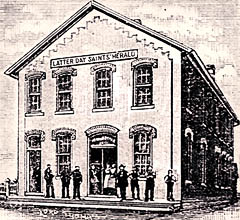
The First Herald Office, Lamoni, Iowa The property at Lamoni consists of a two-story brick building 30x70 feet in size, containing a counting and sales room, a store-room, mailing-room, press-room, in which an excellent Ames engine of eight horsepower furnishes the power, all on the first floor; up stairs, an editorial-room and library containing several hundred volumes belonging to the church; the church recorder's room, now occupied by Elder Henry A. Stebbins, Elder Sheen's successor; a composing-room, where a corps of printers under John Scott, superintendent, set the type for the Herald, the organ of the church; Zion's Hope, a Sunday-school paper; the Sanhedrin's Banner, a Scandinavian paper, and all other church papers and books. The Board of Publication print and keep on sale the books of the church; the "Holy Scriptures," a translation and revision of the Old and New Testaments, by Joseph Smith; the "Book of Mormon" (Golden Bible); the "Doctrine and Covenants" (book of discipline); "Voice of Warning," a "History of Joseph VILLAGES. 789. Smith," by E. Tullidge, a large, fine edition, and one by his mother, Lucy Smith, entitled "Joseph Smith and His Progenitors;" together with tracts in quantity, designed for church work. The office and the plant are valued at near $20,000, and it is undoubtedly the finest establishment of its kind in the State; and the building seen from the trains as the pass to and fro over the Grant City Branch of the Chicago, Burlington & Quincy Railway, makes an imposing and fine appearance. The branch at Lamoni was organized in 1871, with barely a constitutional membership of nine. Elder Charles H. Jones presiding; it now numbers 577. The principal seat of church business is here, the printing office, where the church organ, the Herald, is published, the church library, and the recorder's office and the office of the presidency are all located here. A church 50x90 feet, with the vestibule, having an auditorium 48x78 feet, above, and a room for ordinary lectures, Sunday-school, and prayer service in the basement. The ceiling in the main room is twenty-five feet in height in the center, and has a fine pulpit in walnut, the workmanship and gift of the architect of the building. Thomas Jacobs, resident at Lamoni; the seating capacity of this room is calculated to be 1,000. There are two towers on the front of the building, the one on the north side having a bell of fine tone hung in it. The following epitome contains the principle features of the faith of this singular people. We believe in God the Eternal Father, and in his Son Jesus Christ, and in the Holy Ghost. Matt. 28:19. 1 John 1:3. St. John 11:26. 790 HISTORY OF DECATUR COUNTY. viz., Apostles, prophets, pastors, teachers, evangelists, etc. I Cor. 12:18. Matt. 10:1. Acts 6:4. Eph. 4:11, 2:20. Titus 1:5. The Lamoni Gazette was started in November, 1885, by Sumner E. King, from Mormontown, Missouri. He sold, three months later, to Walker & Hansen, the present proprietors. It is a six-column folio, published on Tuesdays, at $1.00 per year, and independent politically. The only lawyer residing here is W. A. Williams. The first physician at Lamoni was Dr. Bissell. Those now residing here are Drs. J. W. De Noon, J. J. Stafford, J. H. Hansen and D. D. Steiner. The business of Lamoni in 1886 is represented by the following firms: George Adams, mill; Robert Booth, grocery; Blair & Bell, general store; Miss Cazley, millinery; George Derry, harness and shoes; E. H. Dancer, lumber and implements; Z. T. Earl, general stock; William Gray, hotel; W. H. Graham, hotel; VILLAGES. 791. Walker & Hansen, drugs; Hogue, Clum & Bailey, hardware and tinshop; W. Hudson, general store; Hopkins Bros., implements and furniture; George Johnson, jeweler; Miss L. L. Lyons, postmistress; D. F. Nicholson, hardware; Olsen & Lewis, furniture; J. W. Ockerman, station agent; N. M. Reeder, general store; J. B. Rogers, blacksmith; Joe Rabidou, blacksmith; Stoddard Bros., lumber; Thomas Teale & Co., general store; H. L. Tilton, general store; Mrs. Wicks, millinery; Walker & Hansen, Lamoni Gazette. (remainder of text not transcribed) |
Back to top of this page.
The Vault | The Bookshelf | Spalding Library | Mormon Classics | Newspapers
HOME unOFFICIAL JOSEPH SMITH HOME PAGE CHRONOLOGY
last updated: March 5, 2008
